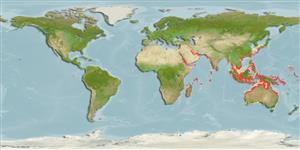Common names from other countries
Environment: milieu / climate zone / depth range / distribution range
Ekologi
; payau, usually 0 - 25 m (Ref. 75831). Tropical
Indo-West Pacific: Reported from East Africa, including South Africa and the Red Sea, to southern Japan, the Philippines, and eastern Indonesia.
Length at first maturity / Size / Weight / umur
Maturity: Lm ? range ? - ? cm Max length : 6.0 cm SHL jantan/; (Ref. 348); common length : 5.0 cm SHL jantan/; (Ref. 348)
The distribution of this species is imperfectly known because of frequent confusion with other species of the genus (Ref. 348). Found in intertidal areas, in mud and sand, (Ref. 75831) and shallow sublittoral waters (Ref. 348). In sheltered bays and estuaries (Ref. 348).
Life cycle and mating behavior
Kematangan | Reproduksi, perkembang biakan | Pemijahan | telur-telur | Fecundity | Larva
Members of the class Bivalvia are mostly gonochoric, some are protandric hermaphrodites. Life cycle: Embryos develop into free-swimming trocophore larvae, succeeded by the bivalve veliger, resembling a miniature clam.
rujukan utama
Acuan | Koordinator | mitra
Poutiers, J.M. 1998. (Ref. 348)
Status IUCN Red List (Ref. 130435)
status CITES (Ref. 108899)
Not Evaluated
Not Evaluated
ancaman kepada manusia
Harmless
penggunaan manusia
| FishSource |
Alat, peralatan
informasi lanjut
Umur / Saiz
Pertumbuhan
panjang-berat
panjang-panjang
Morfologi
Larva
Kelimpahan
Sumber internet
Estimates based on models
Preferred temperature
(Ref.
115969): 24.1 - 29.2, mean 28.2 (based on 1694 cells).
keancaman
Low vulnerability (10 of 100).
